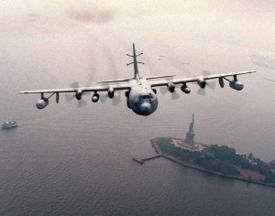PlaneSpottingWorld welcomes all new members! Please gives your ideas at the Terminal.
EC-130 Commando Solo
| EC-130 Commando Solo | |
|---|---|
| An EC-130E Commando Solo II makes a pass over the Statue of Liberty in New York Harbor | |
| Type | Psychological and information operations |
| Manufacturer | Lockheed Aircraft Co. |
| Designed by | Lockheed Aircraft Co. |
| Introduced | 1986 |
| Primary user | United States Air National Guard |
| Number built | 6 |
| Unit cost | US$90 million |
| Developed from | C-130 |
The EC-130 Commando Solo conducts psychological operations (PSYOP) and civil affairs broadcast missions in the standard AM, FM, HF, TV and military communications bands. Missions are flown at the maximum altitudes possible to ensure optimum propagation patterns. The EC-130 flies during either day or night scenarios with equal success, and is air-refuelable. A typical mission consists of a single-ship orbit which is offset from the desired target audience. The targets may be either military or civilian personnel.
Secondary missions include command and control communications countermeasures (C3CM) and limited intelligence gathering. The three variants are EC-130 ABCCC, EC-130E Commando Solo, and the EC-130J Commando Solo.
The version currently in service is the EC-130J. In 2006, the EC-130E was retired from service.
Contents
History
Origins
Development
Entry into service
Design evolution
Highly-specialized modifications have been made to the latest version of the EC-130 (Commando Solo). Included in these mods are enhanced navigation systems, self-protection equipment, and the capability of broadcasting color television on a multitude of worldwide standards through out the TV VHF/UHF ranges. The ABCCC is an Airborne Battlefield Command and Control Center used as an airborne command post. Last, but not least, Compass Call is an airborne communications jamming platform. It was used extensively in the Gulf War disrupting Iraqi communications at both the strategic and tactical levels.
Design characteristics
Combat service
The EC-130 was originally modified by using the mission electronic equipment from the EC-121 Coronet Solo. Soon after the 193rd SOG received its EC-130s, the unit participated in the rescue of US citizens in Operation Urgent Fury, acting as an airborne radio station informing those people on Grenada of the US military action. Commando Solo was instrumental in the success of coordinated psychological operations in Operation Just Cause, again broadcasting continuously throughout the initial phases of the operation to help end the Manuel Noriega regime. More recently, in 1994, Commando Solo was utilized to broadcast radio and television messages to the citizens and leaders of Haiti during Operation Uphold Democracy.
The EC-130s deployed early in the operation, highlighting the importance of PSYOP in avoiding military and civilian casualties. President Aristide was featured on the broadcasts which contributed significantly to the orderly transition from military rule to democracy. In 1990 the EC-130 joined the newly formed Air Force Special Operations Command and has since been designated Commando Solo, with no change in mission. This one-of-a-kind aircraft is consistently improving its capabilities. The next few years should see continued enhancements to the EC-130 and its worldwide mission.
Milestones
Specifications ()
Data from {name of first source}[1]
General characteristics
- Crew: pilot, copilot, flight systems officer, mission systems officer; loadmaster, five electronic communications systems operators
- Length: 97.75 ft (29.7 m)
- Wingspan: 132.6 ft (40.3 m)
- Height: 38.8 ft (11.8 m)
- Wing area: ft² (m²)
- Empty weight: lb (kg)
- Loaded weight: lb (kg)
- Useful load: lb (kg)
- Max takeoff weight: 155,000 lb (69,750 kg)
- Powerplant: 4× AE2100D3 six-blade turboprops
- Dry thrust: lbf (kN) each
- Thrust with afterburner: lbf (kN) each
Performance
- Never exceed speed: knots (mph, km/h)
- Maximum speed: knots
- Cruise speed: knots (335 mph, km/h)
- Stall speed: knots (mph, km/h)
- Range: 2,300 nm (mi, km)
- Service ceiling: 28,000 ft (8,534 m)
- Rate of climb: ft/min (m/s)
- Wing loading: lb/ft² (kg/m²)
Popular culture
References
- ↑ Factsheets: EC-130J Commando Solo. United States Air Force. Retrieved on 2007-03-05.
External Links
Related content
Lists relating to aviation | |
|---|---|
| General | Timeline of aviation · Aircraft · Aircraft manufacturers · Aircraft engines · Aircraft engine manufacturers · Airports · Airlines |
| Military | Air forces · Aircraft weapons · Missiles · Unmanned aerial vehicles (UAVs) · Experimental aircraft |
| Notable incidents and accidents | Military aviation · Airliners · General aviation · Famous aviation-related deaths |
| Records | Flight airspeed record · Flight distance record · Flight altitude record · Flight endurance record · Most produced aircraft |

